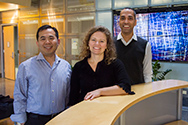Global Environmental Health

NIEHS Climate Change and Environmental Exposures Challenge (Part I)
April 25, 2016
Experts: Julia Gohlke, Ph.D., Dawen Xie, Samarth Swarup, Ph.D., Cyndy Comerford
In the first podcast of this two-part podcast series, we hear about how scientists and communities are using innovative data visualization tools to look at health and resiliency in San Francisco and heat exposures nationwide.
In the first podcast of this two-part podcast series, we hear about how scientists and communities are using innovative data visualization tools to look at health and resiliency in San Francisco and heat exposures nationwide.
NIEHS’s Climate Change and Environmental Exposures Challenge focused on creating data visualization tools and maps that connect current science on climate change to the exposure pathways for environmental hazards. The goal was to help decision makers and communities identify areas and people at greatest risk and help to prioritize protective actions.
In this two-part podcast series, we take a look at the four projects awarded first- and second-place prizes in the challenge. Hear about how scientists and communities are using innovative data visualization tools to look at flooding in St. Louis, climate change in the Near West neighborhood of Indianapolis, health and resiliency in San Francisco, and extreme heat nationwide.
Part 1: Visualizing Climate and Health from the National to the Local Level

Julia Gohlke, Ph.D., is an assistant professor of environmental health in the Department of Population Health Sciences at Virginia Tech. Her research focuses on the human health implications of global environmental change. She uses bioinformatic and alternative model techniques for disseminating the molecular underpinnings of environmental effects on human health. Her laboratory is currently conducting a community-engaged project to determine differences in vulnerability to extreme heat events in urban versus rural settings in Alabama.
Dawen Xie is a senior research associate at the Biocomplexity Institute of Virginia Tech. Xie earned his master’s degree in Computer Engineering at Texas A&M University. His interests are Geographic Information System (GIS), visual analytics, information management system, and databases, with a current focus on building different dynamic web applications.
Samarth Swarup, Ph.D., is a research assistant professor at the Biocomplexity Institute of Virginia Tech. He works on problems at the intersection of public health, urban analytics, network science, and artificial intelligence. He develops agent-based models known as synthetic information systems, which are large-scale, high fidelity, data-driven simulation models of human populations and infrastructures. These models are used in the study of topics including disease epidemiology, environmental effects on health, and disaster response.
The team’s visualization tool is called “Populations, Infrastructures, and Exposures Visualization” or PIE Viz, and can be accessed at: Populations, Infrastructures, and Exposures Visualization PIE Viz.

Cyndy Comerford manages policy and planning at the San Francisco Department of Public Health. In this capacity, she also is the Director the Health Department’s Climate and Health Program and Health Impact Assessment Program. She has a passion for public sector innovation and policy with expertise in a wide range of complex social issues gained through working in government, the private sector and civic engagement. Her efforts focus on creating healthy and equitable cities with extensive experience in public health, climate change, community design, transportation, healthy housing, human trafficking, and emergency planning. Her work on climate change and health has been recognized by The White House, C40 and presented at the 21st Conference of Parties to the United Nations Framework Convention on Climate Change (COP21) as concrete city solutions to climate change that can be scaled and replicated across the world.
Her program's visualization tool is called “San Francisco Climate and Health Profile” and can be accessed at: San Francisco Climate and Health Profile.
Other Episodes in the Same Series


